You'll reveal a world of sensory delights when you master the art of tea textures in herbal blends. Texture markedly impacts your overall drinking experience, with factors like leaf size, brewing method, and steeping time playing essential roles. Different herbs offer unique mouthfeel sensations, from silky smoothness to brisk crispness. By understanding how to balance ingredients and adjust brewing variables, you can create signature blends tailored to your texture preferences. Pay attention to water temperature, steeping duration, and the interplay between smooth and coarse herbs. As you explore these principles, you'll soon be crafting herbal teas that tantalize both your taste buds and your sense of touch.
Understanding Tea Texture Basics
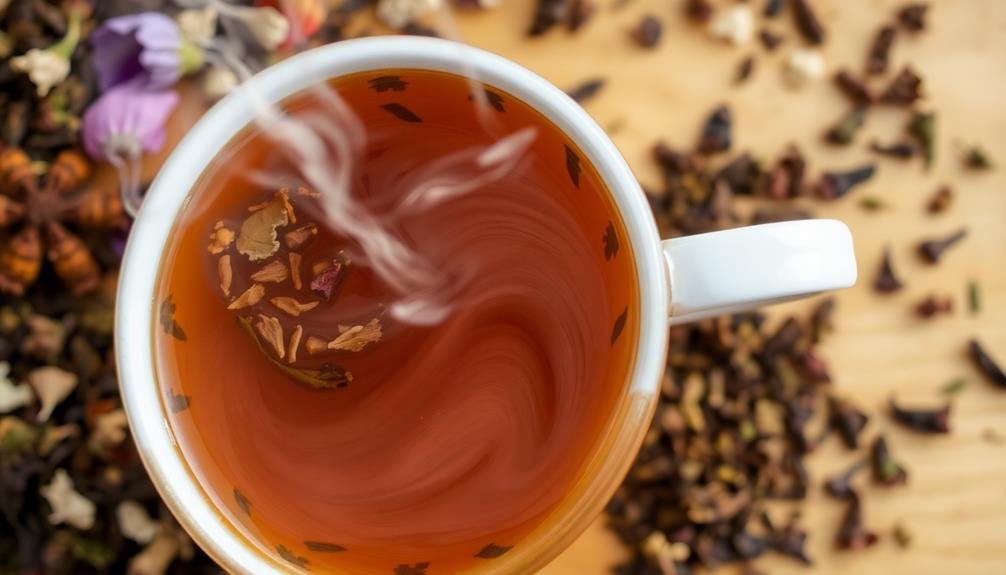
How does the texture of your tea affect your overall drinking experience? It's an essential aspect that often goes unnoticed but greatly impacts your enjoyment. Texture refers to the physical sensation of the tea in your mouth, including its thickness, smoothness, and any particulate matter.
You'll encounter various textures in different tea types. Black teas often have a full-bodied, robust texture, while green teas can be light and crisp. Oolong teas range from silky to creamy, depending on their oxidation level. Herbal infusions offer diverse textures, from the smoothness of chamomile to the slightly thick mouthfeel of rooibos.
Factors influencing tea texture include leaf size, brewing method, and water temperature. Finely ground leaves can create a more substantial texture, while whole leaves often result in a cleaner mouthfeel. Steeping time also plays a role; longer steeps generally produce fuller-bodied teas.
To explore textures, try comparing different tea types side by side. Pay attention to how the tea feels on your tongue and how it coats your mouth. This awareness will enhance your tea-drinking experience and help you identify your preferences.
Mouthfeel Characteristics of Herbal Teas
Moving from general tea textures to herbal varieties, you'll find a vast array of mouthfeel characteristics. Herbal teas offer unique sensations that can range from smooth and velvety to astringent and brisk. Unlike traditional teas, herbals don't contain tannins, which greatly impacts their texture profile.
When exploring herbal blends, you'll encounter:
- Silky smoothness: Often found in chamomile and lavender teas
- Light and crisp: Typical of peppermint and lemongrass infusions
- Rich and full-bodied: Common in rooibos and honeybush blends
The mouthfeel of herbal teas is influenced by the plant parts used, preparation methods, and steeping time. Flowers and leaves tend to create lighter textures, while roots and barks often result in more substantial feels.
You'll notice that some herbs, like licorice root, can leave a lingering sweetness that coats your palate.
To fully appreciate the texture, pay attention to how the tea feels as you sip and swallow. Does it leave your mouth feeling dry or refreshed? Is there a pleasant afterfeel? These nuances contribute to the overall sensory experience of herbal teas.
Factors Affecting Tea Texture
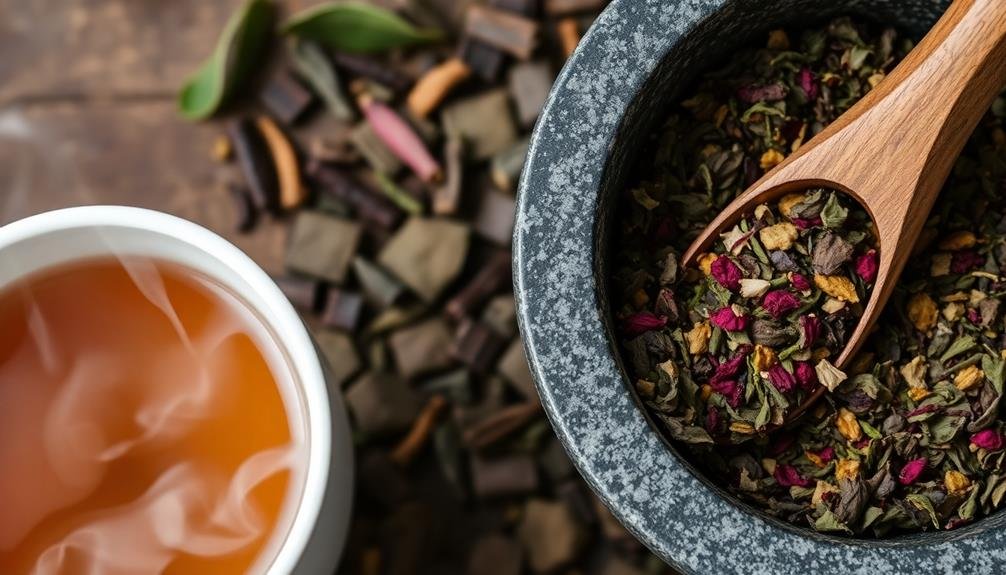
While many factors influence tea texture, several key elements play an important role in shaping the mouthfeel of your brew. The type of herbs you choose greatly impacts texture, with some leaves and flowers creating a smoother feel, while others may add astringency or thickness.
Water temperature affects how compounds are extracted from the herbs, altering the tea's body. Hotter water tends to release more tannins, potentially increasing astringency.
Steeping time also plays a vital role; longer steeps can result in a fuller-bodied tea, while shorter ones may produce a lighter texture.
The fineness of the herb particles influences texture too. Whole leaves often create a cleaner mouthfeel, while finely ground herbs can add thickness and sometimes grittiness.
The water you use matters as well; hard water can make tea feel heavier, while soft water might result in a smoother texture.
Lastly, additives like milk, honey, or lemon can dramatically change your tea's texture. Milk adds creaminess, honey increases viscosity, and lemon can brighten the mouthfeel while adding a slight tartness.
Balancing Ingredients for Optimal Texture
Three key principles guide the process of balancing ingredients for ideal texture in herbal blends. First, evaluate the base ingredient's texture and how it'll interact with other components.
Second, aim for a harmonious mix of different textures to create a well-rounded mouthfeel.
Third, adjust the ratios of ingredients to achieve the desired overall texture.
When creating your herbal blend, you'll want to focus on:
- Leaf size and shape
- Density of ingredients
- Moisture content
Start by selecting your base ingredient, which will make up the majority of your blend. If you're using a light, fluffy herb like chamomile, you might want to balance it with denser ingredients like dried fruit or seeds.
For a smoother texture, incorporate finely cut leaves or powders. If you're after a more robust mouthfeel, opt for whole leaves or larger pieces.
Don't forget to evaluate how different ingredients will interact when steeped. Some herbs may become slimy or gelatinous when wet, while others maintain their structure.
Texture-Enhancing Herbs and Botanicals
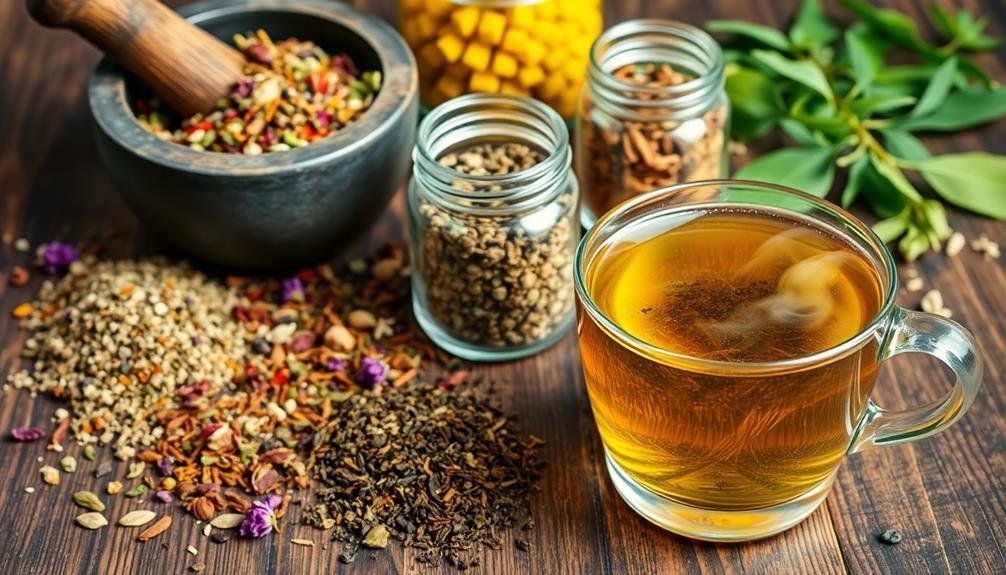
Certain herbs and botanicals can greatly enhance the texture of your herbal blends. When crafting your perfect cup, consider incorporating marshmallow root or slippery elm bark for a silky, smooth mouthfeel. These herbs release natural mucilage, creating a subtle thickness that coats the palate.
For a light, airy texture, try adding a pinch of lemon balm or peppermint. These herbs contain volatile oils that create a revitalizing, cooling sensation on the tongue.
If you're looking to add body without heaviness, consider rose petals or chamomile flowers. They'll impart a delicate, velvety quality to your blend.
To create a more robust, full-bodied tea, experiment with rooibos or honeybush. These South African herbs contribute a rich, almost creamy texture.
For an interesting contrast, mix in some crunchy elements like dried apple pieces or toasted rice. They'll add a surprising textural element that complements softer ingredients.
Don't forget about seeds and spices. Fennel seeds can provide a subtle crunch, while cardamom pods release aromatic oils that enhance both flavor and mouthfeel.
Brewing Methods and Texture Impact
When brewing herbal blends, you'll find that steeping time markedly affects the final texture of your infusion.
You can experiment with shorter or longer steeping times to achieve your desired mouthfeel, from light and delicate to robust and full-bodied.
Water temperature also plays an essential role in extracting different compounds from herbs, influencing both flavor and texture, so it's important to take this factor into account when crafting your perfect blend.
Steeping Time Effects
In accordance with your brewing method, steeping time plays an essential role in determining the flavor profile and texture of your herbal blend. As you steep your herbs, the water gradually extracts compounds, essential oils, and flavors.
Shorter steeping times result in lighter, more delicate textures, while longer steeps produce bolder, fuller-bodied infusions. For most herbal blends, you'll want to experiment with steeping times to find your perfect balance.
Here's a quick guide to help you get started:
- Light infusions (1-3 minutes): Ideal for delicate herbs like chamomile or mint, producing a subtle, invigorating texture.
- Medium infusions (4-7 minutes): Best for balanced blends, allowing enough time for flavors to develop without becoming overpowering.
- Strong infusions (8-10+ minutes): Suitable for robust herbs like ginger or licorice root, creating a rich, intense texture.
Remember that over-steeping can lead to bitter or astringent notes in some herbs. It's always better to start with a shorter steeping time and adjust as needed.
You'll find that different herbs release their flavors at varying rates, so don't be afraid to experiment and fine-tune your steeping times for each unique blend.
Water Temperature Influence
Alongside steeping time, water temperature plays an essential role in extracting flavors and determining the texture of your herbal blend. Different herbs and botanicals require specific temperature ranges to release their ideal flavors and textures. Generally, delicate herbs like chamomile and mint benefit from lower temperatures (175-185°F), while heartier herbs like ginger and cinnamon can withstand higher temperatures (200-212°F).
When you use water that's too hot, you risk over-extracting bitter compounds and creating a harsh, astringent texture. Conversely, water that's too cool may not fully release the herbs' flavors, resulting in a weak, unsatisfying brew.
To achieve the perfect balance, invest in a variable temperature kettle or use a thermometer to monitor your water's temperature.
For herbal blends containing a mix of delicate and robust ingredients, you'll want to experiment with temperatures between 190-200°F. This range often provides a good compromise, allowing for proper extraction without overwhelming the more delicate components.
Texture Profiles of Popular Herbs
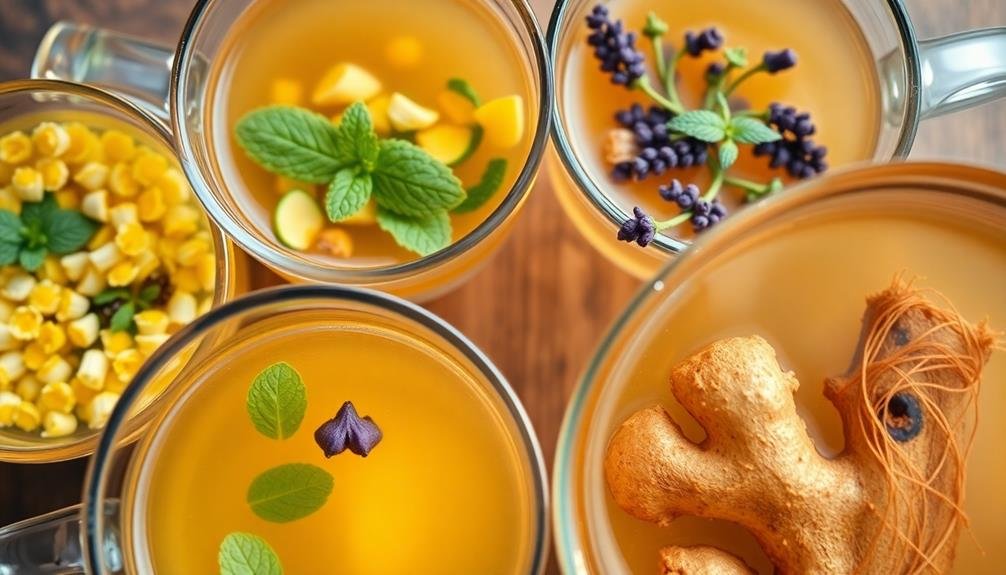
When blending herbs, you'll encounter a range of textures from smooth to coarse.
The leaf shapes and sizes of different herbs can greatly impact the overall texture of your blend.
You'll also find that powdered herbs introduce their own unique textural elements, often creating a finer, more uniform consistency in your herbal mixtures.
Smooth vs. Coarse Herbs
Many herbal enthusiasts overlook the importance of texture when creating blends. Understanding the difference between smooth and coarse herbs can greatly impact your tea's overall mouthfeel and enjoyment.
Smooth herbs, like chamomile flowers and lemon balm leaves, offer a velvety texture that glides effortlessly across your palate. These herbs often release their flavors quickly, providing an immediate sensory experience.
Coarse herbs, such as rosemary needles and dried ginger root, bring a more robust texture to your blend. They can add depth and complexity, creating a multi-layered drinking experience. These herbs typically require longer steeping times to fully release their flavors and properties.
When combining smooth and coarse herbs, consider:
- Balancing proportions to achieve desired mouthfeel
- Adjusting steeping times to accommodate both textures
- Experimenting with different grind sizes for coarse herbs
Leaf Shapes and Sizes
Leaf shapes and sizes play an essential role in determining an herb's texture profile. When creating herbal blends, you'll encounter a variety of leaf types, each contributing uniquely to your tea's overall texture and mouthfeel.
Large, flat leaves like those of mint or lemon balm offer a smooth, velvety texture and release their flavors gradually. They're ideal for creating a full-bodied infusion.
In contrast, small, needle-like leaves such as rosemary or thyme provide a more intense, immediate burst of flavor and a slightly grainy texture.
Crinkled or curled leaves, like those of chamomile or dried nettle, create a more complex texture profile. They tend to unfurl slowly, releasing their flavors over time and adding depth to your blend.
Flowers and petals, such as lavender or rose, contribute a delicate, silky texture that complements other herbs beautifully.
When blending, consider how different leaf shapes and sizes will interact. Mixing various textures can create a more interesting and satisfying tea experience.
Experiment with combining large, flat leaves with smaller, more intricate ones to achieve a balanced and layered texture in your herbal infusions.
Powdered Herb Textures
Powdered herbs offer a unique texture profile that can greatly impact your herbal blends. When working with powdered herbs, you'll notice variations in fineness, density, and how they interact with liquids. Fine powders like matcha green tea dissolve easily, creating a smooth, creamy texture. In contrast, coarser powders like turmeric or cinnamon may leave a slight graininess in your blend.
Understanding these texture differences is essential for creating balanced and enjoyable herbal blends. Here are three key factors to take into account:
- Particle size: Finer powders blend more seamlessly, while coarser ones add texture.
- Absorption rate: Some powders, like psyllium husk, absorb liquid quickly and thicken blends.
- Solubility: Certain herbs dissolve completely, while others remain partially suspended.
To achieve the desired texture in your blends, experiment with different ratios and combinations. You can mix fine and coarse powders to create a more complex mouthfeel.
For smoother blends, try sifting coarser powders or using a high-speed blender. Remember, the texture of your herbal blend can greatly influence its overall sensory experience and enjoyment.
Blending Techniques for Desired Mouthfeel
Creating the perfect mouthfeel for your herbal blend is both an art and a science. You'll need to contemplate the textures of individual herbs and how they interact when combined. Start by identifying your desired mouthfeel: smooth, thick, light, or textured.
For a smooth blend, focus on finely ground herbs and flowers. Mix them thoroughly to guarantee even distribution. If you're aiming for a thicker texture, incorporate herbs with mucilaginous properties like marshmallow root or slippery elm. For a light, invigorating feel, use more leaves and flowers with minimal stems or roots.
To achieve your desired mouthfeel, experiment with different blending techniques:
| Technique | Method | Result |
|---|---|---|
| Layering | Stack herbs in order of density | Creates depth and complexity |
| Pulsing | Brief bursts in a grinder | Maintains some texture while blending |
| Sifting | Use mesh screens of varying sizes | Separates particles for consistent texture |
Remember to taste-test your blends frequently, adjusting proportions as needed. Pay attention to how the texture changes as you steep the herbs, and reflect on how different brewing methods might affect the final mouthfeel of your herbal blend.
Texture and Flavor Pairing Principles
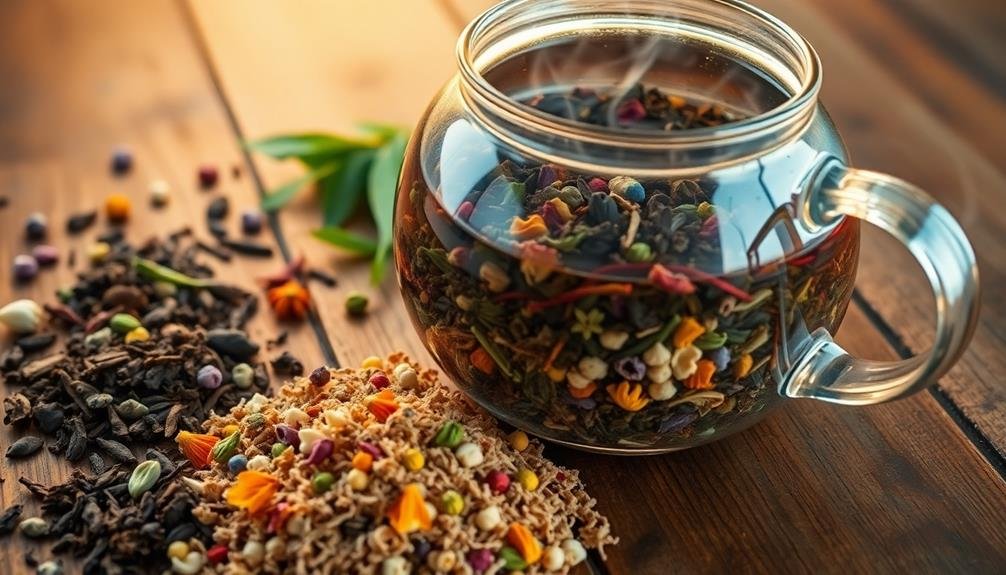
To create harmonious herbal blends, you'll need to master the art of pairing textures and flavors.
Consider combining complementary textures, like soft leaves with crunchy seeds, to enhance the overall mouthfeel. You can also balance smoothness and bite by mixing fine powders with coarser elements, while ensuring that the textures you choose support and elevate the blend's flavor profile.
Complementary Texture Combinations
Beyond flavor profiles, the art of blending herbs extends to texture combinations that can elevate your culinary creations. When crafting your herbal blends, consider pairing ingredients with complementary textures to create a more complex and satisfying experience.
Soft, delicate herbs like chamomile or lemon balm can be balanced with coarser elements such as dried citrus peel or crushed cinnamon sticks. This contrast adds depth and interest to your blend, engaging multiple senses as you sip.
Explore these complementary texture combinations to enhance your herbal blends:
- Smooth + Crunchy: Pair velvety marshmallow root with crisp peppermint leaves
- Fluffy + Dense: Combine light, airy lemon verbena with weighty, chunky ginger pieces
- Silky + Rough: Mix silky rosehip powder with coarse, textured raspberry leaf
Don't be afraid to experiment with different particle sizes and shapes. Fine-cut herbs can be mixed with whole flowers or berries to create a visually appealing blend that also offers a range of textures in each sip.
Balancing Smoothness and Bite
The art of balancing smoothness and bite in herbal blends is a nuanced skill that combines texture and flavor principles. You'll want to create a harmonious mix that offers both comfort and excitement to your palate.
Start by selecting a base herb with a smooth, mellow profile like chamomile or lemon balm. These provide a soothing foundation for your blend.
To add bite, incorporate herbs with sharper notes or textures. Peppermint, ginger, or lemongrass can introduce a pleasant zing that contrasts the smoothness. Be careful not to overpower the blend; a little goes a long way.
Consider using whole leaf teas for added texture, which can create a more complex mouthfeel.
Don't forget about the interplay between flavor and texture. Herbs like licorice root can contribute both sweetness and a unique mouth-coating quality.
Experiment with ratios to find the perfect balance. You might combine 2 parts smooth herbs with 1 part zesty additions for a well-rounded blend.
Mouthfeel and Flavor Synergy
Delving into mouthfeel and flavor synergy reveals the intricate relationship between texture and taste in herbal blends. As you explore different combinations, you'll discover that certain textures complement specific flavors, enhancing the overall drinking experience.
For instance, a smooth, creamy texture often pairs well with rich, full-bodied flavors, while a lighter, crisp mouthfeel can accentuate delicate, floral notes.
To create harmonious blends, consider these key principles:
- Balance contrasting textures: Combine ingredients with different mouthfeels, such as silky chamomile with crunchy rose hips, to create a more complex and interesting sipping experience.
- Match intensity levels: Pair bold flavors with robust textures and subtle tastes with gentler mouthfeels to avoid overwhelming or underwhelming your palate.
- Utilize complementary sensations: Experiment with ingredients that provide similar sensory experiences, like cooling peppermint with invigorating lemongrass, to create a cohesive blend.
Evaluating Texture in Tea Tasting
While flavor and aroma often take center stage in tea tasting, texture plays an essential role in the overall experience. To evaluate texture in tea, you'll need to focus on the mouthfeel and how it changes as you sip.
Start by taking a small amount of tea and letting it coat your tongue. Notice if it's smooth, silky, or perhaps astringent and drying.
Pay attention to the body of the tea. Is it light and delicate, or full-bodied and robust? Some teas may feel thick and creamy, while others are more watery.
As you swallow, observe any lingering sensations. Does the tea leave a pleasant aftertaste, or does it feel rough on your palate?
Consider how different herbs and ingredients contribute to the texture. Marshmallow root can add a silky quality, while hibiscus might introduce a slight tartness.
Experiment with brewing times and temperatures to see how they affect the tea's texture. A longer steep might result in a more intense mouthfeel, while a cooler temperature could produce a smoother texture.
Creating Signature Textured Blends
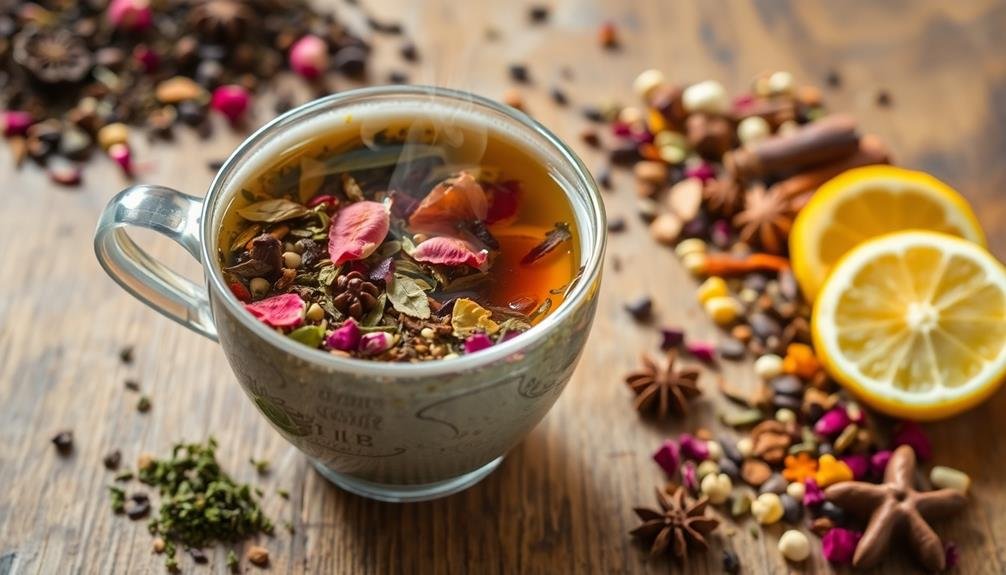
Creating signature textured blends lets you put your personal stamp on herbal teas. By combining different herbs, flowers, and spices, you'll craft unique sensory experiences that engage both taste and touch. Start with a base herb that provides the foundation for your blend, then layer in complementary ingredients to achieve your desired texture profile.
Consider these key elements when creating your signature blend:
- Particle size: Mix fine powders with larger leaves or flowers for varied mouthfeel
- Moisture content: Combine dry and oily ingredients for a more complex texture
- Density: Blend light, fluffy herbs with denser ones for a balanced cup
Experiment with ingredients like velvety chamomile, crisp peppermint, and smooth licorice root to create a range of textures.
Don't forget to include visually appealing elements like rose petals or cornflowers, which can enhance the overall sensory experience.
As you develop your blend, take notes on the proportions and steep times that yield the best results.
Frequently Asked Questions
How Does Tea Texture Affect the Perceived Caffeine Content?
You'll find that tea texture doesn't directly affect caffeine content, but it can influence your perception. Thicker, fuller-bodied teas might feel more energizing, while lighter, smoother teas could seem less caffeinated, even if they're not.
Can Tea Texture Change Based on the Drinker's Body Temperature?
Your body temperature can influence how you perceive tea texture. If you're warm, tea might feel thinner or less viscous. When you're cold, it could seem thicker or more comforting. Your personal state affects your sensory experience.
Are There Cultural Differences in Preferred Tea Textures Around the World?
You'll find cultural differences in preferred tea textures worldwide. In China, you might enjoy thick, creamy bubble tea, while in Japan, you'd savor thin, frothy matcha. Middle Eastern cultures often prefer strong, syrupy brews.
How Does Aging Affect the Texture of Stored Herbal Tea Blends?
As you store herbal tea blends, you'll notice their texture changes. Over time, they'll lose moisture and become drier. Essential oils may evaporate, altering mouthfeel. Some herbs might crumble, while others may clump together, affecting the overall texture.
Can Certain Tea Textures Help Alleviate Specific Health Conditions?
You'll find that certain tea textures can indeed help with health issues. Smooth, creamy teas may soothe digestive problems, while coarse, fibrous blends can aid digestion. Thick, syrupy teas often provide relief for sore throats.
In Summary
You've now revealed the secrets of tea textures and herbal blends. Armed with this knowledge, you're ready to create unique, sensory experiences in every cup. Remember, texture is just as important as flavor in crafting the perfect blend. Don't be afraid to experiment with different ingredients and techniques. Trust your palate, and you'll soon be brewing teas that delight not only the taste buds but also offer a satisfying mouthfeel. Your journey into the world of textured teas has only just begun.

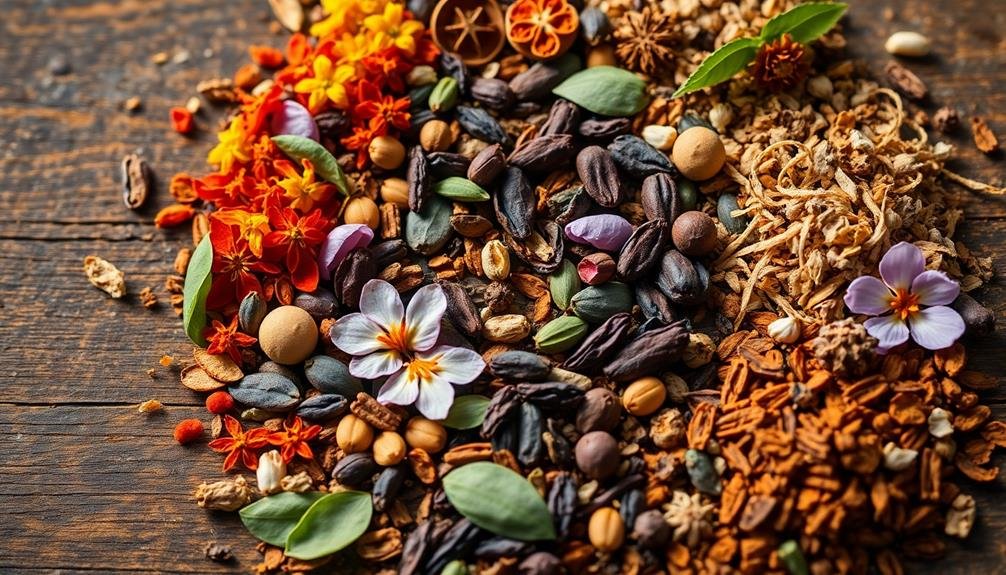



Leave a Reply